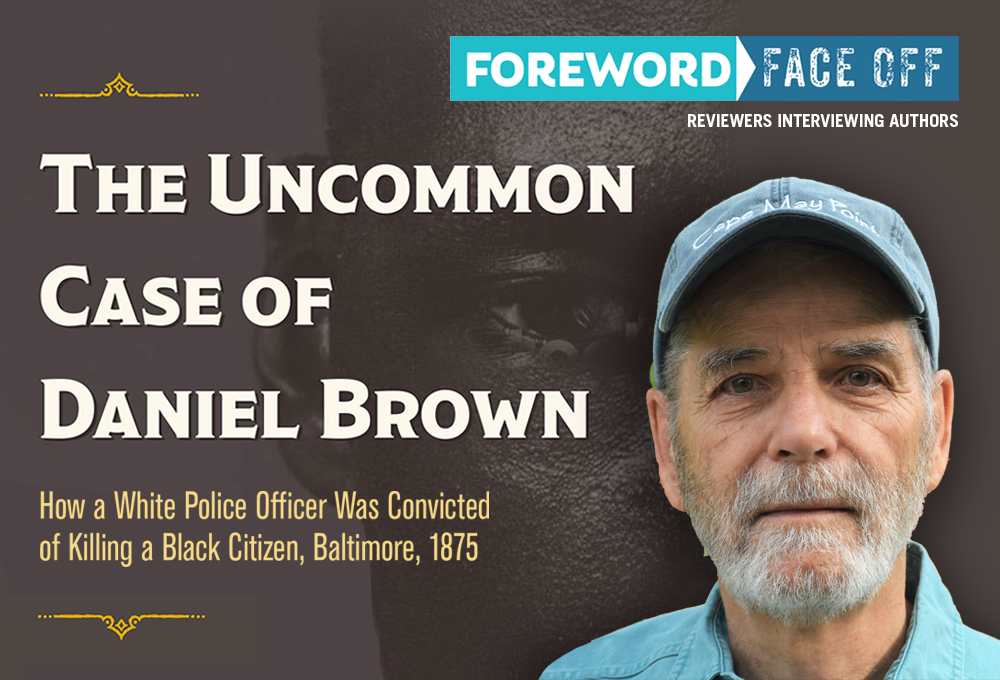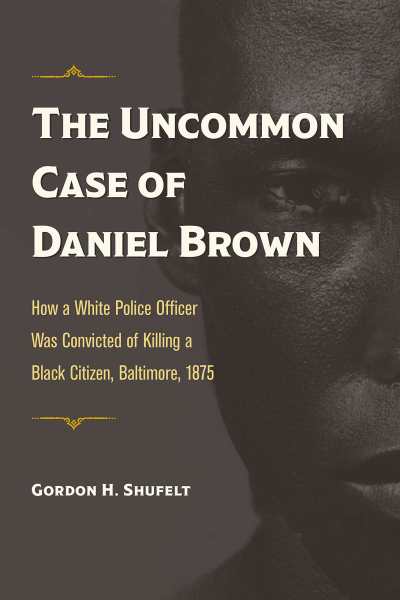Reviewer Meg Nola Interviews Gordon Shufelt, Author of The Uncommon Case of Daniel Brown

Let’s skip the intro niceties and jump right to a passage from Meg Nola’s Foreword review to best understand a remarkable criminal justice event that happened in Baltimore soon after the 
American Civil War: “Historian Gordon H. Shufelt’s true crime book recounts the 1875 murder of a Black man by a white policeman. While racial police brutality is still not uncommon, the grim distinction surrounding Daniel Brown’s death is that, in late nineteenth-century Baltimore, this particular officer was convicted.”
Yes, you read that right: Daniel Brown’s life did matter—Officer Patrick McDonald went to jail.
As we learn in the following conversation, the case of Daniel Brown is brimming with subplots and behind-the-scenes maneuvering. Kudos to Kent State for publishing another important book.
When did you first encounter Daniel Brown’s case, and did Officer McDonald’s conviction surprise you?
I can’t say precisely when I first came upon Daniel Brown’s case. I was working on a different project at the time. It must have been five or six years ago. It wasn’t just the conviction that surprised me—it was the fact that it went to trial at all. I had come across several other cases in which Maryland law enforcement officers killed African Americans, and in every other case I found that a coroner’s inquest had summarily ruled the matter as justifiable on the basis of self-defense or accident. Some of the cases were highly suggestive of wrongdoing on the part of the law enforcement officer, but there was never an attempt to develop the evidence.
Coroners’ inquests at that time were very informal, procedurally-lax hearings and it was easy to avoid matters that might be embarrassing to police officials. Just getting past the coroner’s inquest in such a case was a major accomplishment.
You recreate the factors leading to the murder, and provide a detailed backstory for both Daniel Brown and Patrick McDonald—or as detailed as possible with the available historical records. Brown is described as hard-working and happily married; he gets along well with his neighbors and, despite racial inequity, aspires toward a better life. You also note that Brown was reported to be somewhat “assertive” regarding civil rights. Do you think that Brown’s desire for reasonable and equal treatment caused his encounter with McDonald to escalate?
It’s very difficult to establish with certainty exactly what set off the violence in the encounter in the doorway. But Daniel Brown’s self-confidence and insistence on respect, especially in his own home, certainly comes across in the statements about Brown made by his landlord and his employer. The white people who said Daniel Brown took civil rights questions seriously did not mean that as a compliment. Yet they all added that he was sober, hardworking, and a dependable employee. Some of those in the house at the time testified that Officer McDonald referred to Brown’s responses as “saucy.” My conclusion is that what was simply an attitude of self-respect on Daniel Brown’s part was interpreted by the policeman as an inappropriate lack of deference.
Patrick McDonald came to America as a child with his family, to escape the Irish Famine of 1845-55. Your descriptions of the famine’s horrors convey why Irish immigrants were desperate to leave the blight and oppression of their homeland. Yet many Irish found that after being dominated by the British, they were now discriminated against by Anglo-Americans. How did that affect the Irish in Baltimore?
Many, if not most, nineteenth-century Irish immigrants believed they were driven into exile as a result of British colonialism. The famine and disease of the 1840s and 1850s was to Irish immigrants a horrible example of British maladministration. In the US the immigrants encountered discrimination. On the face of it, it would seem they might have identified with African Americans as fellow victims of oppression. But the key to understanding Irish immigrants’ place in Baltimore is the relationship between Irish immigrants and the city’s Democratic Party. Throughout most of the nineteenth century, the Democratic Party dominated Maryland politics, and Democrats openly identified themselves members of the “white man’s party.” In Baltimore, Democrats made an alliance with the Irish immigrants and relied on their votes. In this alliance, Irish immigrants and their Irish-American children found political leaders who were friends and protectors rather than oppressors, as the British had been. And, perhaps more importantly, the alliance with the party of white supremacism allowed the Irish to see themselves as members of the dominant group rather than as an oppressed caste, as they had been under British control of their homeland.
After the Civil War, Baltimore’s economy and population were booming. You note that Baltimore was also one of the first American cities with an organized police force. Prior to Daniel Brown’s murder, there had been an increasing number of complaints about police overreach, made by white and Black residents. Was this a factor in bringing Brown’s case to trial?
The uniformed, militarized police force—in basic outlines, the police we are familiar with today—first appeared in Baltimore and other cities in the mid-nineteenth century. In most cities, not just Baltimore, the new police forces got off to a bad start because political leaders used them to control elections. My argument, however, is that the problem of abusive policing was more intense and more enduring in Baltimore because Baltimoreans were bitterly divided during the Civil War, with tens of thousands of Marylanders fighting on the US side and tens of thousands on the Confederate side. As different factions gained political control for short periods in the unusual circumstances of the mid-century US crisis, each side in turn used the police against the other. Not only African Americans, but many white citizens felt the sting of police bullying. And in the Fall of 1875, in the months leading up to Officer McDonald’s trial, Maryland’s municipal and state elections were closer and more bitterly contested than usual. By all accounts, the Baltimore police behaved badly during these election campaigns. White resentment of police bullying was certainly a factor in getting the case all the way through the criminal justice system to the trial stage. It was not the only factor—other social divisions and the exceptionally shocking nature of the attack on Brown also mattered—but resentment of the police may have tipped the balance.
On the night of his death, Daniel Brown hosted a small party at his home. The strongest beverage served was ginger beer, and the 19th-century party games were decidedly wholesome in nature. A noise complaint was made to the police, however, because the festivities went past midnight. Officer McDonald insisted that the guests were drinking alcohol and participating in questionable behavior, and Daniel Brown most likely “bristled” over these accusations. So it seems that McDonald was trying to intimidate Brown and make a moral judgment?
Even if we assume Officer McDonald was deeply committed to an ideology of white supremacism, his violent response seems hard to explain. He apparently expected deference and perhaps believed a gathering of African Americans was inherently disorderly or dangerous. He was a relatively inexperienced officer, and perhaps felt more insecure about his authority for that reason. The incident occurred very late—after 1:00 AM—which might have led McDonald to believe the event was disorderly. In fact, it was probably late because many of the guests were domestic servants who were required to work well into the evening, especially on a weekend when their employers may have required servants to work at the employers’ social events. For people who might be required to work past 9:00 PM, relaxing at a gathering until 1:00 AM would not be unusual or indicative of wild behavior. But perhaps Officer McDonald—culturally, socially, and politically isolated from African Americans as he was—did not understand that.
Daniel Brown’s wife, Keziah, testified against McDonald at his trial. What effect did her account of the incident have?
There is nothing in the event that is more moving than Keziah Brown’s testimony. She did not testify at the coroner’s inquest. Her testimony at the trial was her first public statement, and for that reason probably drew extra attention. She testified that she stood between the police officer and her husband after her husband was clearly disabled by a blow from the policeman’s club. When the policeman raised his pistol, she asked him not to kill her husband. According to her testimony, McDonald actually put his hand on her shoulder and pushed her out of the way so he could shoot Daniel Brown in the head. She knelt beside Daniel and watched him die. It is hard to believe that even an avowed white supremacist would not be moved by Keziah Brown’s testimony.
After Officer McDonald’s conviction, a judge’s “sentencing error” reduced the number of years that McDonald actually served for the crime. Was this possibly deliberate, and do you believe that the error would have occurred if Daniel Brown had been white?
As a result of the sentencing error, Officer McDonald not only served an indefensibly short sentence (less than a year), but he served the sentence in the city jail, not in the penitentiary. At the city jail he was protected by his fellow city police officers. I can’t be sure the error was intentional, but the trial judge had several years of experience in the Baltimore City Criminal Court—all his cases involved criminal matters and he had given sentences in manslaughter convictions before. The statute that prescribed the sentencing is very clear—if the sentence was longer than two years, the convict had to go to the penitentiary, not the city jail.
Judge Gilmor’s “mistake” is certainly suspicious. The way the case was handled on appeal was also suspicious. Arguably, the law provided a way for the appellate court to correct the error and send Officer McDonald to the penitentiary to serve his full five year sentence. The matter as to the appellate procedures was not as clear as the trial court’s legal issue, but the reasoning in the appellate court was not thorough. I believe the matter was, at best handled carelessly, which is disturbing in light of the seriousness of the crime. I do not believe if the victim had been white in a case where the facts showed such an egregious crime the case would have been handled this way.
Meg Nola
